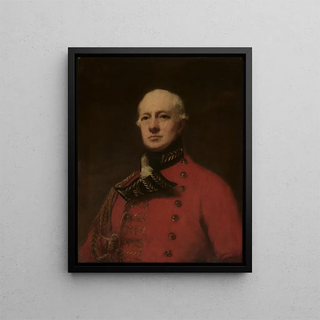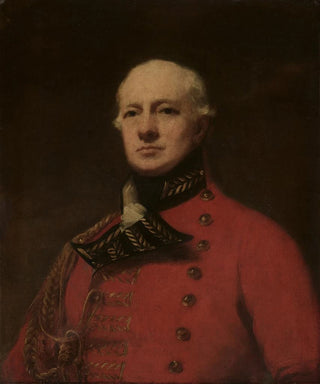Art print | Lieutenant-General Duncan Campbell - Sir Henry Raeburn


View from behind

Frame (optional)
In the panorama of Scottish art history, the art print "Lieutenant-General Duncan Campbell" by Sir Henry Raeburn stands out for its psychological depth and striking realism. This portrait, which captures the essence of an influential statesman of his time, immerses us in the heart of the 18th century—a period marked by political and social upheavals. The representation of Campbell, with his penetrating gaze and confident posture, evokes not only the stature of a military man but also that of a man deeply rooted in his era. The magic of this painting lies in its ability to transcend the simple portrait to become a true window into the soul and character of its subject.
Style and uniqueness of the work
Raeburn's style, both classical and innovative, is fully expressed in this iconic art print. The artist excels in the art of light and shadow, creating an almost tangible atmosphere around his subject. The texture of the clothing, the delicacy of the features, and the richness of the colors demonstrate remarkable technical mastery. Using shades of brown and blue, Raeburn manages to bring Duncan Campbell to life, making the viewer almost an accomplice in his story. This art print does not merely depict a man; it tells a life, a career, and an era. The way the general is staged, with a simple background that emphasizes his presence, reflects a thoughtful consideration of the role of portraiture in the society of his time.
The artist and his influence
Sir Henry Raeburn, an emblematic figure of Scottish painting, established himself as one of the most respected portraitists of his era. His background, marked by training in London and diverse influences, led him to develop a unique style that combines tradition and modernity. Raeburn captured the spirit of his time, making his portraits vivid testimonies of 18th-century Scottish society. His works, including "Lieutenant-General Duncan Campbell," are perfect examples that have inspired many artists, both of his time and subsequent generations. The artist succeeded in establishing a connection between the subject and the viewer, transforming each portrait

Matte finish

View from behind

Frame (optional)
In the panorama of Scottish art history, the art print "Lieutenant-General Duncan Campbell" by Sir Henry Raeburn stands out for its psychological depth and striking realism. This portrait, which captures the essence of an influential statesman of his time, immerses us in the heart of the 18th century—a period marked by political and social upheavals. The representation of Campbell, with his penetrating gaze and confident posture, evokes not only the stature of a military man but also that of a man deeply rooted in his era. The magic of this painting lies in its ability to transcend the simple portrait to become a true window into the soul and character of its subject.
Style and uniqueness of the work
Raeburn's style, both classical and innovative, is fully expressed in this iconic art print. The artist excels in the art of light and shadow, creating an almost tangible atmosphere around his subject. The texture of the clothing, the delicacy of the features, and the richness of the colors demonstrate remarkable technical mastery. Using shades of brown and blue, Raeburn manages to bring Duncan Campbell to life, making the viewer almost an accomplice in his story. This art print does not merely depict a man; it tells a life, a career, and an era. The way the general is staged, with a simple background that emphasizes his presence, reflects a thoughtful consideration of the role of portraiture in the society of his time.
The artist and his influence
Sir Henry Raeburn, an emblematic figure of Scottish painting, established himself as one of the most respected portraitists of his era. His background, marked by training in London and diverse influences, led him to develop a unique style that combines tradition and modernity. Raeburn captured the spirit of his time, making his portraits vivid testimonies of 18th-century Scottish society. His works, including "Lieutenant-General Duncan Campbell," are perfect examples that have inspired many artists, both of his time and subsequent generations. The artist succeeded in establishing a connection between the subject and the viewer, transforming each portrait






